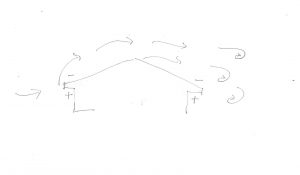Wind Load on Shop Eaves – ASCE 7-22 – Envelope Procedure – MWFRS
Now let’s look at the wind loading on the shop eaves. We ignored them previously, as we were getting `big picture’ wind loads on the building as a whole … or at least an 8-ft `swath’ of building, as a big wind hits it from the side. Again we’re using the Envelope Procedure of ASCE 7-22 Chapter 28. Section 28.3.5 Roof Overhangs requires that we apply a GCp of 0.7 to the underside of the overhang along with the GCpf from Figure 28.3-1 for the upper surface. From our previous posts, the GCpf values were -0.69 for the windward roof, and -0.47 for the leeward. Let’s consider 18-inch eaves (overhangs). From before, qz = 18.4 psf.

Here goes…
Windward eave pressure: p = qz Kd (GCpf – CGp) = 18.5 psf (0.85) (-0.69 – 0.7) = 18.5 psf (0.85) (-1.39) = 21.8 psf (the minus sign dropped as we know it’s acting upward and outward).
Leeward eave pressure: 18.5 psf (0.85) (-0.47 – 0.7) = … 18.4 psf (upward and outward).
For an 18-inch overhang:
Windward upward force on eave, per longitudinal foot of wall: F per foot = p x A per foot -21.8 psf x 18/12 ft x 1 ft = 33 plf (rounded). For an 8-ft `swath’: 33 plf x 8 ft = 260 lb.
For the leeward eave: F = 28 plf (rounded) or 220 lb, for the 8-ft swath.
Note again that the windward upward force magnitude is greater than the leeward … causing a `negative drag’, and that the horizontal component of which must be ignored, for the MWFRS, per Section 28.3.3.
But the added vertical forces are:
Windward: 260 lb cos (18.4°) + 220 cos (18.4°) = 460 lb … (8-ft swath).
If the shop is 100 ft long, we’re adding … another 460 x 100 / 8 = 5600 lb. What does a car weigh? Apparently the average small car weights about 2500 lb. Maybe we need to park a couple (more cars on the roof, one on the windward eave, and one on the leeward, to keep it from flying away.)